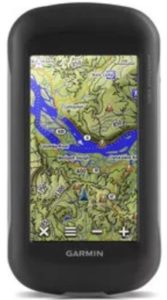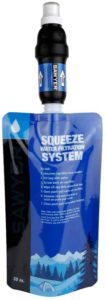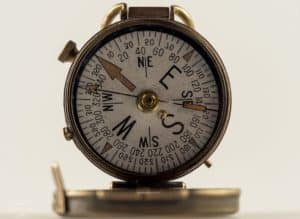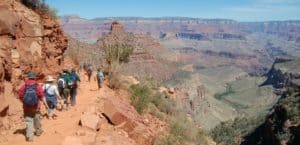Making mistakes is a part of life. How we manage these mistakes and grow from them is what makes life exciting and enjoyable. These are the top mistakes we make when we first start hiking and group hiking. Some of these are second nature if you’re an experienced hiker, but consider passing this along to someone just getting started. When the first time hiker avoids these mistakes, their time outdoors will be much more enjoyable.
Being Too Ambitious for Your First Hike
There’s nothing wrong with being ambitious but being dangerously ambitious can get you and others injured or worse, killed. I’ve heard so many stories about some new hikers going on their first solo trip having a goal that’s just a little too far out for their reach, given their experience. Weather changes so fast up in the mountains; this is why we prepare for worst-case scenarios.
The weather conditions in the mountains can change dramatically from one hour to the next. In just a few minutes, a thunderstorm can roll in when the sky was perfectly clear, and in only a few hours, the temperatures can drop from hot to temperatures that are below freezing. The path up the mountain can be covered entirely in show giving you nowhere to go.
Be ambitious, don’t hold yourself back but know your limitations and don’t do anything too off the scale. Practice hikes in the summer and where other people will be on the trail.
The climate on a mountain varies depending on our altitude. At the foothills, it might be a tropical climate, while the peaks may be covered in ice. Mountains receive more rainfall than low lying areas because the temperature on top of the mountains is lower than the temperature at the base. Winds carry moist air over the land. When air reaches the mountain, it rises because the mountains are in front of the desert landscape. As the air rises, it will cool, and because cool air can carry less moisture than warm air, there is usually precipitation.
Here in Southern California, we have a harsh area called Death Valley. One of the significant reasons the area is so dry is because it sits in the rain shadow of four major mountain ranges.

Communication With Other Backpackers
This comes down to communicating with the people you’re going to have with you on the trail. Talk about the route, gear that’s going to be needed, and who will bring what. If you’re going with a group, it’s easier to divide the gear among everyone to reduce weight and baggage.
It’s a mistake to rely on someone that has never been hiking to bring necessary items like food and fuel if they have never been out for more than a few days. Make sure each person is perfectly clear on their responsibilities.
One of the first long hikes I ever went on, my brother and I were responsible for bringing all the food. Neither one of us had ever been on a long 10-day hike before; we vastly over packed and overestimated the food we needed for the group.
Communicate with someone that is not going on the trip of where exactly you will be going and when you’ll be back. Let them know if they haven’t heard from you by a specific time to send help. This might be the most important thing when going out into the mountains.
Consider a GPS tracker for emergencies. The Garmin Montana 680t Handheld GPS is one of the best trackers available right now, and it might save your life in a crisis. Some of the complaints I see about this GPS tracker is confusion about city mapping.
It isn’t as robust and real-time as Google maps on our phones. This is made for tracking and mapping while mountaineering. Just make sure to read the full description before investing in this GPS tracker. See the current price and learn more about the Garmin Montana 680t on Amazon here.

Backpacking Gear Check-Off
Before packing your backpack, get your gear check-off list ready. It’s effortless to forget stuff when your excited to go hiking. With your backpack on the ground, lay everything out you’re going to bring. Make sure to separate your gear in different color dry bags and think about your daily activities when backpacking and what you need.
Here’s an illustrated article I wrote about choosing a dry bag and how much will fit in each size. If you’d like a thought jogger on what to bring, here’s a general gear check-off list from REI, you can it print out and mark off as you put your gear together.

Check all your old gear. My main internal frame hiking backpack is getting long in the tooth. I don’t know if I trust the pack on longer hikes anymore, so be aware of any piece of gear you love, but might be too worn out to trust. This certainly goes for hiking boots as well.
High-quality hiking boots are an excellent investment, but I tend to go through them quickly. Consider picking up something new or at least testing them to make sure they will last the entire trip. The last thing we need is a sole ripping off our boots days up in the mountains.

Test All Your Gear Before You Leave
Test and understanding your gear before headed on the trail. This is one I’ve been guilty of myself. A few years ago, a planned hiking trip was approaching quickly. A few days before, I decided I didn’t want to hike with my more massive two-person tent, so I ordered a lightweight one-person tent on Amazon.
The day it arrived was the day we left backpacking. I didn’t set the tent up or even make sure everything needed was in the packaging. That night when we reached our camp, we quickly needed to set up our tents as the rain started pouring down. It took me twice as long to set up a new tent then it should have because I didn’t test it before our trip.
Start Hiking Cold
When you actually start hiking a great rule is to start cold. This is especially true when high up in the mountains, and it’s cold because once you start hiking after five minutes, you’ll get warm quickly.
Instead of being warm with multiple layers of clothing wanting to hike, I always recommend starting with one or two fewer layers so you won’t have to stop after five minutes of hiking to remove those layers.
Warm-up a little while still at camp. Remove a layer of clothing and do some stretches and a few squats to get the heart rate up.
Weight Is Not the Most Important Thing, Safety Is
There are so many videos on YouTube and articles about counting grams and keeping your hiking weight down. The truth is safety, above all else, matters the most. This is why 42% of all rescue cases are day hikers.
They were not prepared for nightfall and didn’t have the basic knowledge of navigation to get back to their vehicle safely. It comes down to common sense and personally responsible. If you want to read more, this National Geographic article is about day hikers being the most vulnerable.

Drinking-Water Safely While Hiking
There are many different ways of filtering and purifying water, and it really depends on the location you’ll be hiking. The simplest and cheapest way is to use purification tablets. These tablets make contaminated water bacteriologically suitable to drink within 35 minutes.
Even if your preferred drinking water is through a filter or boiling water, purification tablets are a must-have to keep in your backpack for emergencies. They are a great way to purify a large quantity of water for a group inside the camp.
There are many different charcoal filters or UV water purifiers on the market. The one that I recommended is the Sawyer Squeeze Water Filter. This system includes the Sawyer Squeeze Filter, two 32 fl. oz. pouches, a cleaning coupling, and additional accessories for gravity and inline use.
It also gives you the option to drink water directly from the spout as well. The filter uses a hollow-fiber membrane that removes 99.9% of all bacteria while only weighing 3 ounces. This filter has a very reasonable price, and you can learn more about it on Amazon here.

It’s essential to find an excellent place to source your water. A couple of things to think about is to try and source your water directly from the earth. If there’s water coming from a fountain or tiny stream where it’s being filtered from rocks and earth, it’s probably going to be a good source of water, some of the best you can find.
Another thing to think about when pulling water from a stream is the likelihood of a dead animal being directly above the water source. This thought has crossed my mind hiking in areas with cattle. If it’s at all possible, make the effort of getting water as high up as you can.
If you do have a bad experience with water, your trip is going to go downhill quickly. Having purifying tablets with a good water filter is a good backup plan.

Backpacking Navigation Skills
There are so many things on the market now to keep us from getting lost. GPS, as mentioned above, navigation apps on phones and wristwatch navigation. The problem with all of these is they rely on batteries. Having a general understanding of maps and always knowing where north is comes in handy if our battery systems fail.
Things get very serious quicky, with feeling lost. You don’t have to be a professional navigator, but just knowing basic navigation can save lives.
I would write about how to read a compass, but I found this article on outdoorsbeing.com that goes through everything we should need starting out. Here’s a link to the compass article.
A good habit is always to know where north is, even at work and around town. My kids are still small, but I’ll ask them where north is when we’re driving or in the city.

Physical Preparation
It’s straightforward to underestimate how hard a climb or hike is going to be. Some physical preparation is needed even on seemingly easy trails. If you put some extra effort in before your trip, the hike will be more enjoyable, reducing the chance of injury, and you’ll be able to take in more scenery along the way.
There are many exercises and stretches for hiking, but the most useful thing I’ve found is to climb stairs. Going up and downstairs for the sake of exercise isn’t fun, but the payoff is worth the effort.
On a recent backpacking trip with my brother, we were headed down the mountain back to our vehicle. We were stopped by two exhausted hikers that we’re headed to the first lake.
While it’s always encouraging to let people know they’ll be at their destination soon, we had to tell them they were still a few hours away. They had a look of despair on their face.
This is why physical preparation is just as necessary as the gear you choose to put in your pack.
You Choose Your Friends
The people with you on the hike will make or break your trip. Remember, you’re going to be sharing a lot of conversations with everyone around you. I’ve found that the first couple of days during a long trip, the conversations come easy. Something about the outdoors really makes people open up.
After the first few days, the conversations can become shorter, and I’ve learned to give my fellow hikers some more space. Silence and enjoying nature is a big part of being outdoors.
This isn’t just hiking and camping related. I’ve noticed the same thing in running groups as well. Be mindful that for new members, it can be challenging for them to keep up with more experienced hikers. Make sure to be encouraging along the way by taking breaks as needed.

Bringing Too Much Stuff Camping
We’ve all done it! Bringing too much food, clothes, or just generally packing the stuff we don’t need, or that will never get used. This is where group hiking can be very beneficial. I always bring a few items for redundancy like my telescoping fish pole, but in the unlikely chance my stove stop working, I can borrow someone else’s in the group.
Make a list of stuff you need on the next hiking trip right after your last trip. This is probably one of the best tips I can give a new hiker. After the first long trip with family members, I sprawled all my gear and my backpack on the floor.
Seeing some stuff I just never used, such as my Kindle and large Carhartt jacket, I decided never to retake these. Did I really need those three pairs of blue jeans?
Experience and Embracing Mistakes
We all make mistakes. No one was born being the best at something. Looking back at your past, cringing at some of the things you’ve done only means you’ve grown as a person. Embrace and learn from your mistakes; look forward to the future.
